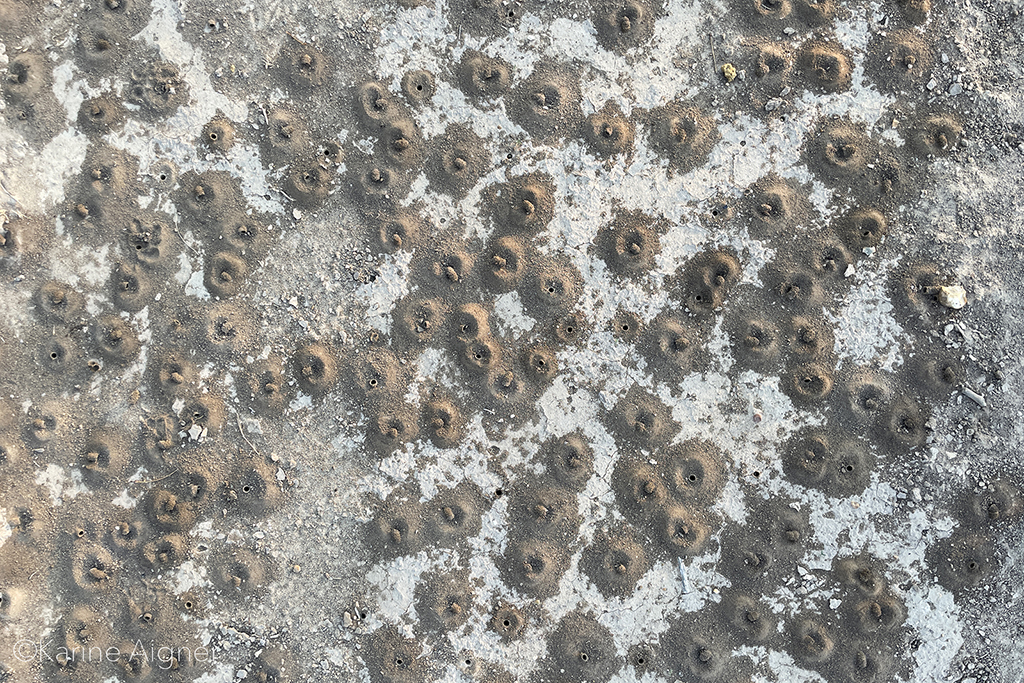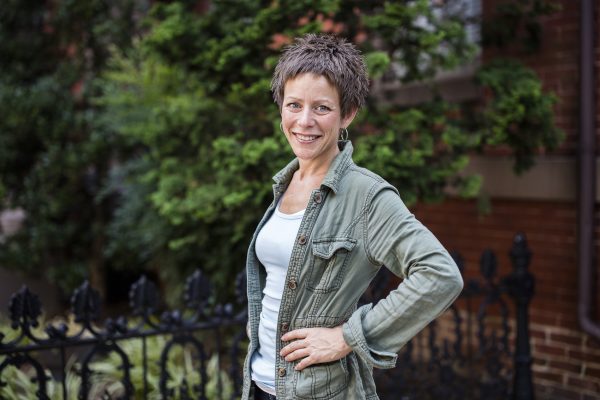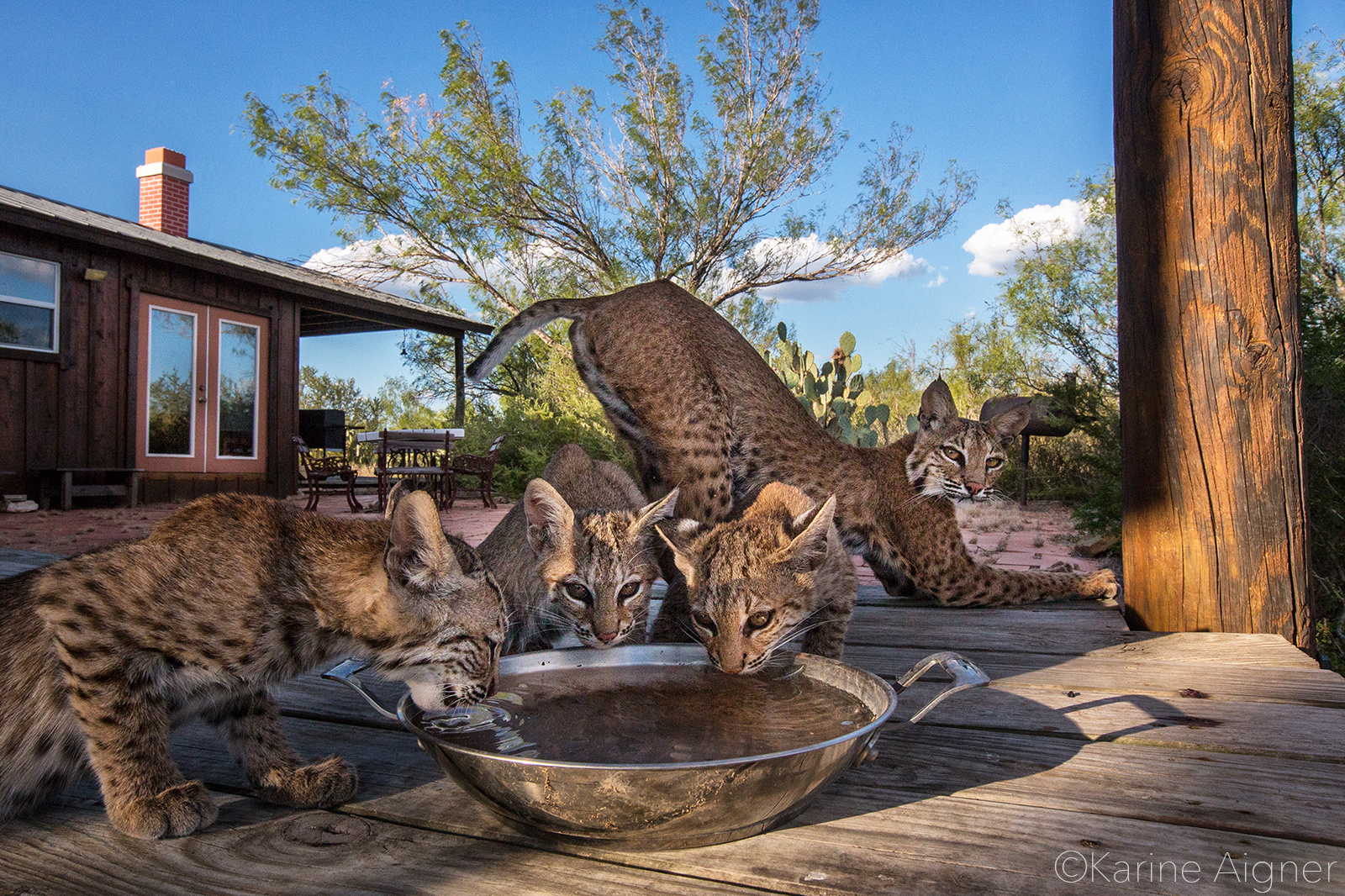Karine Aigner had no idea what she was witnessing when she chanced upon a field of “mini volcanoes” on a ranch near Cotulla where she’s been working and living sporadically for several years. The sometime Texan and itinerant wildlife photographer was driving on a dirt road when she noticed masses of tiny mounds across the landscape. Thinking they were ant mounds, she pulled over.
Aigner quickly realized she wasn’t looking at ants. “I was looking at individual bees,” she said.
Intrigued, she monitored the plot for several weeks. The day she took the award-winning shot pictured above in May of 2021, she was on her way back to the ranch house when she noticed birds dive bombing.
“As I got closer I could see the entire ground seemed to be moving. There were bees ‘balling’ all over the place…they would form, then dissipate…form then reform.” Aigner said she wasn’t planning to shoot photos that day, but after seeing the captivating spectacle, she retrieved her Sony a7R3 camera and macro Laowa Probe lens and started photographing. She snapped about 1,200 photos over several hours.

Cactus bee nest mounds at a ranch near Cotulla, Texas. –Photo courtesy Karine Aigner
In October of 2022, one of the photos, “Big Buzz,” won the Natural History Museum in London’s prestigious 2022 Wildlife Photographer of the Year award. Carrying a £10,000 prize (about $12,000), nature photographers consider the recognition equal to an Academy Award. “It’s like the Super Bowl for nature photographers,” said San Antonio Report photo editor Scott Ball.
What Aigner captured constitutes one dramatic moment in the reproductive cycle of the solitary Cactus bee, Diadasia rinconis. The Cactus bee, one of approximately 20,000 bee species worldwide, most of which are solitary, lives a lonely life most of the time. Unlike European honeybees, solitary bees don’t build hives, make honey or have intricate social networks led by a queen.
“We don’t really hear much about them because when most people hear ‘bee,’ they only think of the European honey bee,” said bee expert Jessica Beckham, Associate Professor of Instruction in UTSA’s integrative biology department. The fuzzy insects can be spotted in San Antonio and much of the western U.S. she added, citing recent observations on iNaturalist, the citizen science nature observation app.

Karine Aigner, 2022 Wildlife Photographer of the Year –Photo courtesy Karine Aigner
Beckam explained that Cactus bees are ground nesters. The anthill-like mounds Aigner observed were formed by the soil the female bees dug up to burrow tunnels and chambers for egg laying inches beneath the earth. Each female provisions her own nest, foraging for pollen for weeks, bringing it back and stashing it in the chambers. They the lay one egg per chamber on pollen balls they’ve stored so when the larvae emerge, they have food to eat before crawling out into the world via the tunnel channeled by their mother.
Beckam said some Didasia species complete their metamorphosis and emerge the same year they are laid; others overwinter as larvae and emerge in the spring. The males emerge first. “The females lay their eggs for females further back in the nest,” said Beckam, before stuffing the tunnels with dirt to protect them. Then they die.
When the female Cactus bees emerge, the males await them. The male bees compete for the right to pass along their genes by fighting in the bee brawl captured by Aigner.
“It’s pretty brutal,” said Beckam.
At least one scientific paper suggested that size matters in the Didasia males’ fight to reproduce. “We found that larger males were better able to procure mates and copulated for shorter periods of time,” scientists wrote in a 2018 paper.
Aigner said, that like many of us, she didn’t even know solitary bees existed before the Cotulla encounter. “I fell in love with this species,” she said.
Aigner found her way to Texas more than 10 years ago after serving as a judge for the Coastal Bend Wildlife Photography Contest, which later changed its name to Wildlife in Focus. At the judges lunch, she met Claire Vaughan, a longtime San Antonio resident, rancher and conservationist. Aigner and Vaughan became friendly and after learning that Aigner had never been to a ranch, invited the photographer to visit her and her husband George’s place in South Texas.
Aigner did, and was struck by the stunning biodiversity and wealth of wildlife. The first time, she stayed four months, and while she owns a condo in Washington, D.C., she spends more time at the ranch and on the road than in the nation’s capitol. Aigner and Vaughan have been working together on photography conservation projects ever since–staging workshops for children and adults in wild settings to promote wildlife conservation. connecting people to the land with a camera.
One of Aigner’s pet projects has been documenting the life of a family of bobcats that have joined her solitary lifestyle by taking up residence under the porch of the cabin where she sleeps. In the style of Jane Goodall, her solo presence has created a bond with the wild creatures and they seem to have accepted her, allowing incredible access for close-ups and video that she shares on social media as the “the Bobcat Chronicles.”

Each evening, Momcat and the kittens emerged from under the house and headed straight to a water bowl kept filled by the ranch owner. The family would stretch and groom and play, until Momcat disappeared into the bush to hunt. –Photo courtesy Karine Aigner
Aigner has become so friendly with the bobcats that she’s assigned them names–Momcat and LG for the adults.
She described a scene whereby a bobcat kitten was seized by a coyote when the family was hanging out near the cabin. She went on the porch with her camera and sat down. The adults sent the remaining two kittens up a tree while standing guard–one on a nearby ledge, the other sitting next to Aigner after calmly sniffing her camera.
Does she ever worry about being attacked? “No!” she said. “People always ask and I just don’t have an innate fear…I’ve always seen animals as individuals with lives and am never afraid of being with them.”
The daughter of a commercial airline pilot and flight attendant, Aigner grew up in Saudi Arabia and the Netherlands, and can’t seem to stop traveling. She earned a degree in television from Boston University, taught English in Taiwan, worked in New York City at NBC, and Psychology Today, and eventually at National Geographic Kids where she served as photo editor for nine years.
She quit in 2011 because she “wanted to do what I was hiring people to do–photograph wildlife.” Since, it’s been a freelance and freewheeling life. She’s photographed apes in Kenya, jaguars in the Amazon, the bats at Bracken Cave and Cactus bees near Cotulla.
When she’s not traveling on assignment or communing with bobcats or bees, Aigner organizes wildlife photography tours and workshops, and participates in the nonprofit, Girls Who Click. The organization provides free photography classes to teen girls and encourages them to enter the mostly male field of nature photography, and to use their work to further conservation efforts around the world.
Related posts:
- Should we give up avocados to help save the monarch butterfly roosting sites?
- Flower “bed” works overtime as bachelor pad for solitary male bees
- Votes are in! Mealy Blue Sage wins 2022 Pollinator Plant of the Year
- 2022 Unofficial Pollinator Plant of the Year: Engelmann’s Daisy or Gayfeather? Please vote!
- Cowpen daisy: Unofficial pollinator plant of the year 2019
- 2020 Unofficial pollinator plant of the year: Gregg’s mistflower
- How to plan a successful butterfly garden
- Mostly native butterfly garden outperforms lawn every time
Like what you’re reading? Don’t miss a single post from the Texas Butterfly Ranch. Sign up for email delivery, like us on Facebook, or follow us on Twitter, @monikam.


Tremendous opportunity to live a great life in rural Texas – envy of a Texan living in Virginia missing home in Guadalupe County, Texas
Great story. So many people don’t know about the many native bumblebees! Thanks for covering this story.
I loved this story. Jane Goodall and Tom Mangleson started the Cougar Fund You should check it out. They would LOVE to hear about the bobcats. (Tom Mangleson if you dont know is an award winning wildlife photographer.) Penny, is the office manager, so please look them up. This is right up your alley. WELL DONE and congratulations on the photography credits. Maybe we can get a group to go on a photo shoot with you and TOM????YES PLEASE.
https://cougarfund.org/
This is my favorite column of yours ever! Last year I got some great photos of a male Diadasia rinconis bee napping in a white prickly poppy. Like a fuzzy tiny teddy bear.
love living in the Texas Hill country next to Balcones Canyonlands Heaven on earth !!!
I love this story! My .18 acre Leander yard as well as rural acreage property are devoted to wildlife. I am truly amazed at what all come to my yard and less than 15 acre property by managing them as Wildlife Habitat. Growing up in Texas, my family had a 1,000 acre Central Texas ranch. It served as a babysitter and playground for this Texas girl. How I wish we still had it! I love our state’s diversity of wildlife. Let’s all take care of it to preserve it for future generations! I am teaching Landscaping With Natives classes, sharing native plants and seeds as well as participating in wildland activities.